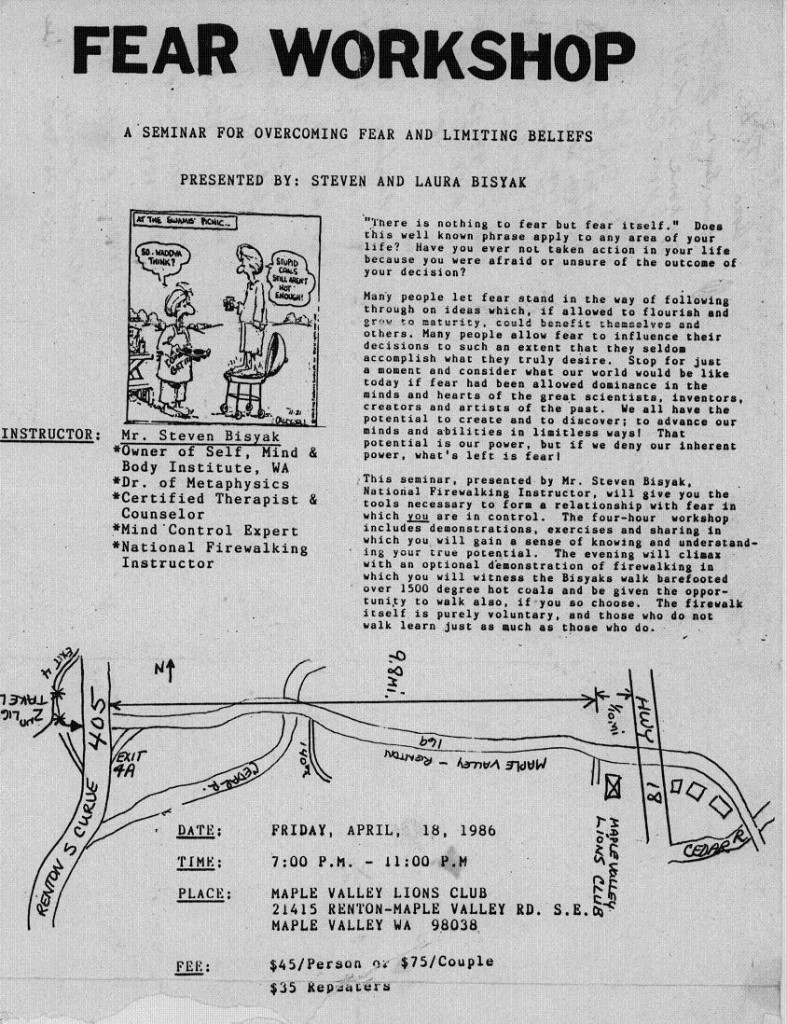BY
ARII-PEU TAMA-ITI
(CHARLES W. KENN)
<H2
Ordained and Initiate Firewalker
A report on four firewalking performances in Honolulu, and a critical study of them from the point of view of the initiate firewalker instead of that of the onlooker.
These tests and critical studies of fire-immunity were made in conjunction with similar studies and investigations being conducted by HUNA RESEARCH ASSOCIATES.
For further information address,
HUNA RESEARCH ASSOCIATES
c/o Max Freedom Long
P. O. Box 2867
Hollywood Station
Los Angeles 28, Calif.
INTRODUCTION
The publication of this report by Charles W. Kenn, marks the first really important step taken in years in the direction of understanding firewalking and related phenomena.
His findings and conclusions are of such a nature that they open once more the entire question of fire immunity which was partly closed in the past decade by tests and reports which now appear much less than valid.
Despite the reluctance of "science" to accept evidence of the verity of the materials of psychic science and its various branches, progress is being made toward fuller understanding.
On the part of the Huna Research Associates, I wish to congratulate Mr. Kenn on his outstanding work. For the first time, here is set before the public a full and careful report on firewalking from the point of view of the firewalker himself.
(Signed)
MAX FREEDOM LONG
ILLUSTRATIONS
Fig. 1.
The master firewalker, Tu-nui Arii-peu and his young assistant, both from Huahini, with Charles W. Kenn.
Fig. 2.
Turning the hot stones over and leveling and firming them just before the firewalking.
Fig. 3.
Tur-nui Arii-peu leads the procession across the very hot stones. Insert shows him at the time of a later test, in native costume, pausing to recite an invocation after crossing the pit. He carries ti-plant wand on shoulder.
Fig. 4.
The author of the report firewalks.
Fig. 5.
The firewalkers' contemplative expression may be seen here. Nearly all experienced a peculiar mental state during the walk.
Fig. 6.
Note the wrapt expression on the face of the lady just finishing her successful firewalk. Assistants stand anxiously by lest there be another accident or fall on the hot stones.
Fig. 7.
The successful firewalkers did not hurry. With short steps on the uneven surface and with an expression akin to that of sleep-walkers, they made the crossing. Heat was felt on hands and face, but not on the feet. Prickling was the only sensation in the feet unless something broke the spell and sharp pain was felt. Soles were cool to the touch after contact with the hot stones. Crossings took from 5 1/2 seconds to 8 seconds. The Chief took 9 seconds for his crossings.
Fig. 8.
After the firewalking. Child finds stone hot enough to burn fingers. Below her hand a wad of paper is beginning to char. At the far corner a stick is beginning to smoke as a young man watches. In heating the stones the green wood first covered the stones with soot. The stones later became red-hot and the soot was burned away. Some stones split when their hotter sides were turned up to the air before the performance. Immediately before a firewalk, a cracked stone, later walked on, registered a surface temperature of 620 degrees Centigrade on the hotter upturned side, and 598 degrees at the bottom of the crack.
FIREWALKING
FROM THE INSIDE
Up to this time we have had the results of firewalking tests placed before us by men of science and by travelers, but have never been given the firewalker's side of the story.
As the reports thus far available give no valid explanation of the phenomenon of fire-immunity in its several forms, it is apparent that it is high time for the persons who are able to do such things as firewalking, to be given their say in the matter.
The scientists are not entirely to blame: for the omission of acceptable information as to (1) the training of the firewalkers, (2) their beliefs and educational backgrounds, and (3) the rituals used as a preparation for the firewalk. The scientists failed to give needed information on these points, either because it seemed too unimportant to stress, or because they could not obtain it from the firewalkers such information often being held both sacred and secret, as in Polynesia.
The University of London Council for Psychical Investigation, when reporting on the tests made of Kuda Bux, wrote, "He (Kuda Bux) stated that any impurity in the fire (of wood and charcoal) such as cow dung, would inevitably burn him. He also offered to walk on red-hot stones, if we wished. …Kuda Bux stated that his immunity from burns was due to `faith'; that he had to ask a 'higher power' in India whether he might perform the feat. He also claimed that he could convey his immunity from burns to another person and take him over the fire without injury. …Before … the first walk, he stood in the end of the trench (filled with glowing coals ) on a wooden platform that had been placed there for that purpose, and, with left hand upraised, muttered a prayer from the Koran. He then carefully brushed away the ash from the embers, with his hand. He said he sometimes uses a fan. He then stepped on the fire, taking four steps, each foot being in contact with the embers twice … There was no sign of blistering … paper tossed on the fire blazed almost instantly."
The conclusion of the report was not greatly enlightening. It was, in part, "… it is possible … with chemically unprepared feet (not calloused) to take four rapid steps on (burning) charcoal at (a surface temperature of) 430 degrees Centigrade, without injury to feet."
Later reports made on similar tests with Hussain, gave no additional information, but it was decided at that time that anyone could firewalk if he only had the courage, and walked steadily across the coals. This conclusion was reached after an Englishman who had these qualifications, performed a short firewalk better than Hussain. The flaw in the conclusion seemed to be that not everyone was able to qualify. However, the world was told to dismiss the idea that there might be an element of magic or of the supernatural in the firewalk.
An inspection of the mass of information available on the externals of other kinds of fire-immunity makes it clear to the layman that the famous reports in question are wanting in many respects, and that the conclusions reached are not at all final. In his book, THE SECRET SCIENCE BEHIND MIRACLES, Max Freedom Long has assembled evidence of a very striking nature which. bears on this point. Performers have, several times a day, held red-hot iron bars gripped tightly between their teeth while bending them up and down at the free ends. The enamel, of the teeth showed no cracking, but such heat applied as a test to newly extracted teeth cracked the enamel instantly. A blow-torch used for cutting steel was allowed to play on the throat of the same performer. He repeatedly chewed up live coals a half inch in diameter, and he drank boiling water so hot that it bubbled violently in the cup. In the records of spiritualistic phenomena, fire has been handled in similar ways, and D.D. Home held his bushy head in the flames in a fireplace without being scorched, also doing the same with flowers and fine fabric. He presented a blazing log to a woman observer and she held it in her arms with no injury to skin or clothing.
It is evident to the student who is looking for the answer to the secret of fire-immunity not simply for a negation of the phenomenon that the shortness of the time in which feet contact heated substances in the firewalk, is NOT THE COMPLETE EXPLANATI0N.
In making the tests about to be described; and while keeping in mind the findings and opinions of the scientists and their friends, my attention was directed primarily to the psychological side of the matter. Tests of temperature and of the length of time for feet to contact stones were secondary.
However, it is necessary to describe the externals first, to prove the genuineness of the demonstrations.










